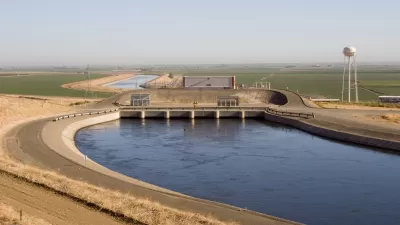This piece from Scientific American looks at the jurisdictional challenge of conserving water in the cross-state Ogallala Aquifer, one of the world's largest sources of freshwater and the backbone of the nation's farm economy.
"The Ogallala Aquifer, the vast underground reservoir that gives life to these fields, is disappearing. In some places, the groundwater is already gone. This is the breadbasket of America-the region that supplies at least one fifth of the total annual U.S. agricultural harvest. If the aquifer goes dry, more than $20 billion worth of food and fiber will vanish from the world's markets. And scientists say it will take natural processes 6,000 years to refill the reservoir.
The challenge of the Ogallala is how to manage human demands on the layer of water that sprawls underneath parts of eight states from South Dakota to Texas. As landowners strive to conserve what's left, they face a tug-of-war between economic growth and declining natural resources. What is happening here-the problems and solutions-is a bellwether for the rest of the planet."
"...By 1980 water levels had dropped by an average of nearly 10 feet throughout the region. In the central and southern parts of the High Plains some declines exceeded 100 feet. Concerned public officials turned to the U.S. Geological Survey, which has studied the aquifer since the early 1900s. With their state and local counterparts, USGS officials began monitoring more than 7,000 wells to assess the annual water-level changes.
What they found was alarming: yearly groundwater withdrawals quintupled between 1949 and 1974. In some places farmers were withdrawing four to six feet a year, while nature was putting back half an inch."
Thanks to Waterwired
FULL STORY: The Ogallala Aquifer: Saving a Vital U.S. Water Source

Planetizen Federal Action Tracker
A weekly monitor of how Trump’s orders and actions are impacting planners and planning in America.

Maui's Vacation Rental Debate Turns Ugly
Verbal attacks, misinformation campaigns and fistfights plague a high-stakes debate to convert thousands of vacation rentals into long-term housing.

San Francisco Suspends Traffic Calming Amidst Record Deaths
Citing “a challenging fiscal landscape,” the city will cease the program on the heels of 42 traffic deaths, including 24 pedestrians.

Defunct Pittsburgh Power Plant to Become Residential Tower
A decommissioned steam heat plant will be redeveloped into almost 100 affordable housing units.

Trump Prompts Restructuring of Transportation Research Board in “Unprecedented Overreach”
The TRB has eliminated more than half of its committees including those focused on climate, equity, and cities.

Amtrak Rolls Out New Orleans to Alabama “Mardi Gras” Train
The new service will operate morning and evening departures between Mobile and New Orleans.
Urban Design for Planners 1: Software Tools
This six-course series explores essential urban design concepts using open source software and equips planners with the tools they need to participate fully in the urban design process.
Planning for Universal Design
Learn the tools for implementing Universal Design in planning regulations.
Heyer Gruel & Associates PA
JM Goldson LLC
Custer County Colorado
City of Camden Redevelopment Agency
City of Astoria
Transportation Research & Education Center (TREC) at Portland State University
Jefferson Parish Government
Camden Redevelopment Agency
City of Claremont




























